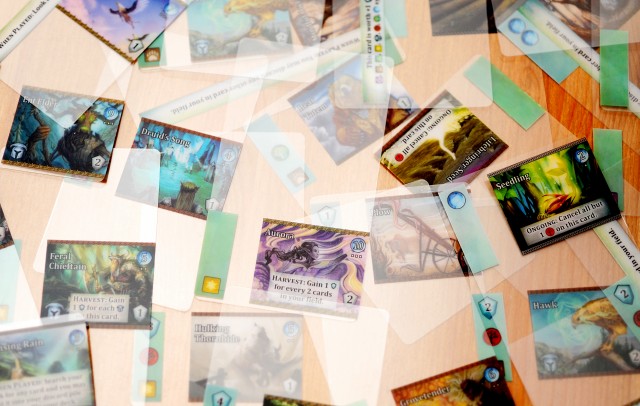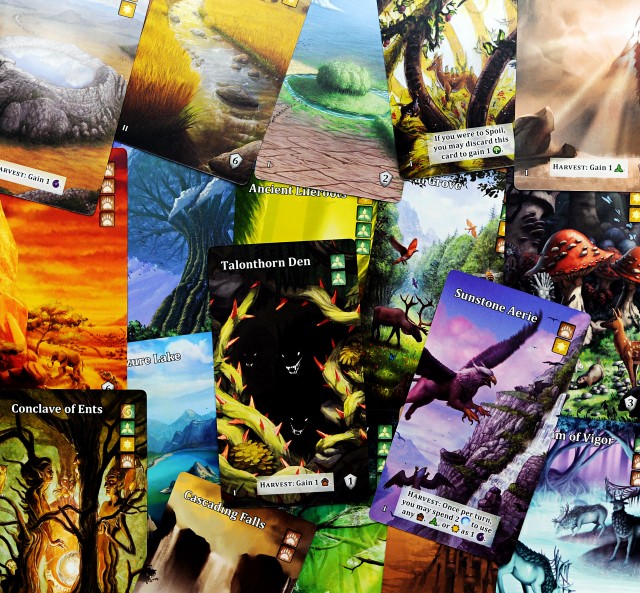One trick with designing new games is finding fresh and innovative ways to work with existing mechanics. There are thousands of different worker placement games, so how do you make yours interesting enough for people to shell out money for it? Dominion kicked off an endless stream of deck building games. Some of them had some inventive approaches to the mechanic and others were just rehashing the same thing over and over again. Mystic Vale came out this year with a ton of buzz. Fans of deck building games were more than ready to embrace a new idea that would change the genre.
Mystic Vale is technically a Card Crafting System, not exactly deck building. With a brilliant use of card sleeves and transparent cards, you’ll customize your starting deck, without ever adding actual cards to it.
The story goes that with his final breaths, an evil king cursed the once beautiful and lush Valley of Life. The sacred valley was full of the spirits of nature, but as the land rotted the spirits were corrupted and now they threaten to leave the valley and continue to decay the lands they come across. Players take on the role of Druids sent to the valley to try and battle the corruption and restore life and health to the sacred lands.
The real star of Mystic Vale is the Advancement cards and how they’re implemented. Each Advancement card in the game has a feature in either the top,  middle or bottom section, meaning that there can be up to three different elements to each card. Advancements are transparent cards that have some currency, special ability, point generation, or even Decay on them, in either the top, middle, or bottom section. When an Advancement gets added to a starting card it’s slid into the card sleeve, giving that card those new characteristics on future turns. You can never cover up anything when adding Advancements, so choosing where to add one can be pretty important. As the game continues you can customize or craft your cards and that is a similar but unique effect to building a deck.
middle or bottom section, meaning that there can be up to three different elements to each card. Advancements are transparent cards that have some currency, special ability, point generation, or even Decay on them, in either the top, middle, or bottom section. When an Advancement gets added to a starting card it’s slid into the card sleeve, giving that card those new characteristics on future turns. You can never cover up anything when adding Advancements, so choosing where to add one can be pretty important. As the game continues you can customize or craft your cards and that is a similar but unique effect to building a deck.
Each player has a starting deck consisting of sleeved cards without a heck of a lot on them. Most of the cards are completely blank, but a few have Fertile Soil which provide Mana (one of the currencies of the game) or Cursed Lands which provide Mana and Decay (a way to spoil your turn) on them. Each turn will start with a ‘hand’ of cards flipped over face up, so that there are three Decay symbols showing. To prep for this players will end each turn by creating their hand for the next round. This consists of flipping cards until there are two Decays in the hand and the top card of the deck (which is also flipped and considered part of the hand) also has a Decay showing. With three Decays you’re safe and can spend a full turn trying to restore life to the valley, but a fourth Decay will cause you to spoil and you’ll get only the compensation of a single Mana for your troubles.
The first part of every turn is the Planting phase. This is where the druids must decide to push their luck and flip more cards or to pass and play out their turn with what they’re already gathered. If they successfully push they can decide to stop then and continue their turn, but if they spoilt their turn ends immediately. If they don’t spoil they get to move on to the Harvest phase. This is where you get to collect all your Mana and eventually your Spirit Symbols and you’ll resolve any Harvest abilities you have on any of the card you have in play. This is when you’re able to buy Advancements to add to the cards you have in play or Vale cards. In the Discard phase you replenish the Advancements and Vale cards and discard the cards you have in play and then finally in the Prep phase you’ll create your hand for the next turn by flipping cards starting with the on deck card until you have three Decays showing.
 Vale cards are bought with the second currency in the game, Spirit Symbols. They will do various things for you like the Azure Lake which provides a Mana for you each round or the Pool of Light which generates a wild Spirit Symbol each round. Usually the in game effects are permanent and can be accessed each round. Some Vale cards will simply earn you end game points, which isn’t too shabby either.
Vale cards are bought with the second currency in the game, Spirit Symbols. They will do various things for you like the Azure Lake which provides a Mana for you each round or the Pool of Light which generates a wild Spirit Symbol each round. Usually the in game effects are permanent and can be accessed each round. Some Vale cards will simply earn you end game points, which isn’t too shabby either.
The timer for the game is the victory point tokens. A certain amount are used depending on the number of players and when they run out the current round is completed and then players total their score in VP tokens, Advancements, and Vale cards.
The card crafting system is VERY intriguing. For someone who has played a ton of deck builders, it’s refreshing to see someone do something really innovative with the idea. That being said, there is not yet enough variety to make a game like Mystic Vale an instant classic. There needs to be expansions to further flush out what is a great start. The good news is that Vale of Magic, the first expansion has already been announced. It seems clear that AEG is determined to support this unique title. The designer, John D. Clair is focused on bringing more card crafting games to market and it seems just a matter of time before imitators start popping up. The nice thing about Mystic Vale is that it seems like a game that might cause a shift. Will it be big enough to impact the hobby or will card crafting be a passing fad? Hard to say at this early stage, but Mystic Vale is fun and the potential it represents is very enticing!
Comments
No comments yet! Be the first!